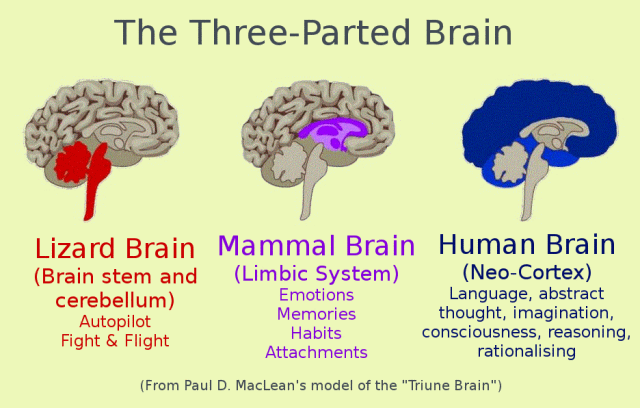

In the 1960's physician and neuroscientist Paul MacLean developed the triune brain theory. In this theory MacLean proposes a model of human brain development that occurred in three stages.
In the oldest part of the brain, we find the brain stem, and cerebellum and basal ganglia, commonly referred to as the reptilian brain complex or Lizard brain. This part of the brain is hard wired for survival and oversees the neurochemical and hormone response that drives our behavior. This part of the brain controls autonomic functions and instinctual survival behaviors such as aggression, dominance, territoriality and ritual displays. As it is focused on safety and controls the autonomic function, this coincides nicely with Maslow's theory of Human Motivation- the first two levels are our physiological needs (breath, Water, Food, Sleep) many of our physiological functions are autonomic. We don't have to think about breathing or digesting our food. The second level sf Maslow's theory of Human Motivation are safety and security needs. As this oldest part of the brain is responsible for functions in both these arenas of motivation.
The second part of the brain in Maclean's theory is known as the mammalian brain or feeling brain. This part of the brain has also been called the paleomammalian brain or midbrain. It includes the limbic system which is composed of the amygdala, hippocampus, and cingulate cortex. This part of the brain is primarily involved in emotional processing, motivation instincts and reproductive behaviors. This part of the brain is associated with our memories, emotions, habits and attachments. In Maslow's theory of human motivation, after our physiological and safety needs have been met, we focus on our need of love and belonging. This ties in well with this mammalian emotional center, this is our feeling brain, and it helps us form bonds and attachments with caregivers, partners, children and our communities. This part of the brain works with the reptilian brain to interpret cues of safety or danger. When our feelings indicate danger to this feeling part of the brain, it enlists the reptilian brain to keep us safe, by producing the neurochemicals and hormones necessary for fight or flight. When this part of the brain feels safe and in control of the environment, it will send cues of safety that allow the reptilian brain to produce the chemicals that establish a rest and digest state.
Finally, the neocortex, or neo-mammalian brain is the newest part of the brain and the part of the brain associated with thinking, reason, making plans and decisions. It helps us to process language, abstract thoughts, consciousness, reasoning and rationalizing. Once again, this theory aligns well with Maslow's theory of human motivation. After we meet our physiological needs and feel safe, we are ready to employ reasoning in our decisions, live our full potential, connect with something greater than ourselves and employ creativity and passions in a way that aligns with our purpose and highest aspirations.
Each of these three areas and the activities contained within involve a complex, integrated interaction between all areas of the brain. While the triune brain theory has fallen out of favor in contemporary neuroscience, I believe it provides a template that helps us understand how different parts of the brain work independently and in tandem to meet the needs that motivate us.
More recently, in Lisa Feldman Barrett's popular book, Seven and a Half Lessons About the Brain, she questions this theory stating that we have only one brain and pointing out the simplicity of this theory which neglects the complex interactions. Perhaps we could alter the Triune Brain Theory to call it the Triune mind.
Either way, The executive function, located within the neocortex or thinking brain plays a critical role in organizing all of the intricate details and interactions between the three minds. This is the part of the brain which determines how to divvy up our mental, physical and physiological resources. The executive function organizes information, prioritizes resources and activity of the mind-body.
the impulses, feelings, and thoughts that our more primal and emotional brain regions generate. Understanding Paul MacLean's triune brain theory illuminates why we behave the way we do and how our needs and motivations evolve over time. Although contemporary neuroscience may offer critiques and refinements to MacLean's model, the core idea—that our brains have developed in complexity over millennia, and that this complexity underlies our thoughts, feelings, and behaviors—remains a powerful framework for understanding human nature.
Grasping the interplay between the reptilian complex, the limbic system, and the neocortex can significantly enhance our self-awareness and empathy towards others. It gives us a roadmap for understanding our most basic instincts, emotional responses, and rational thoughts, how these elements intertwine, and at times, conflict with each other. This awareness can lead to more mindful responses to stress, improved emotional regulation, and better decision-making. By recognizing the origin of our motivations and behaviors, we can strive towards a more balanced and fulfilling life.
Moreover, integrating an understanding of the triune brain into our daily lives and interactions can foster a more compassionate society. It can help us appreciate the complexity of human emotions and behaviors, encouraging patience and support for oneself and others as we navigate our varied needs and aspirations. Realizing that the brain functions both independently and as a whole encourages a holistic approach to mental health, emphasizing the importance of nurturing each aspect of our being.
In conclusion, knowing about the triune brain theory offers valuable insights into the human condition, providing a framework that can enhance personal growth, improve relationships, and contribute to a more empathetic and understanding world. As we continue to explore the mysteries of the brain and mind, theories like MacLean's serve as essential steppingstones, reminding us of the intricate systems that make us who we are and inspiring us to strive towards a better understanding of ourselves and humanity. Regardless of the simplicity or criticism of the triune brain model, its essence beckons us to delve deeper into the marvels of the human brain, continuously improving our condition and how we interact with the world around us. Here is a revised model which incorporates some of the criticisms of the original model.






0 Comments